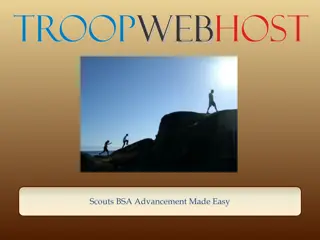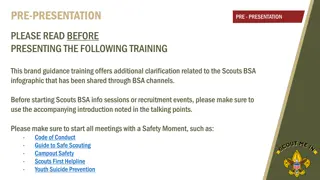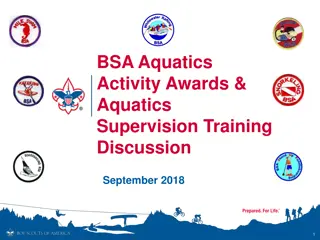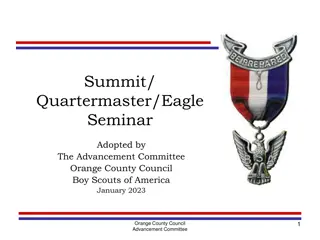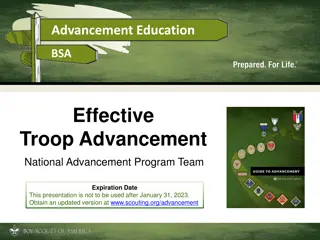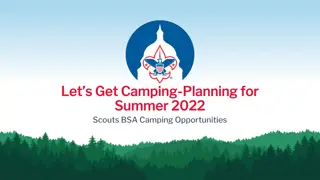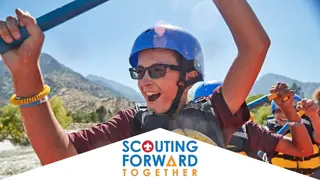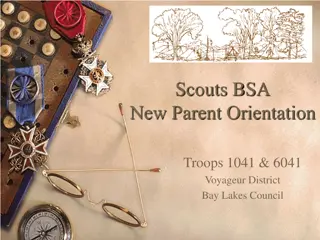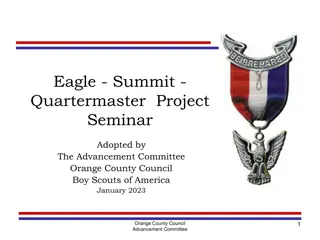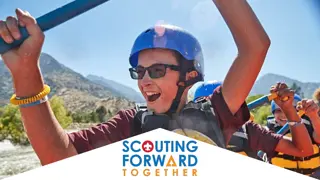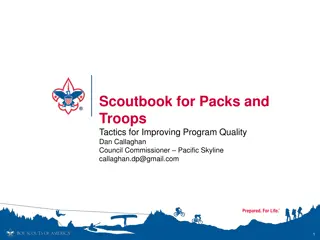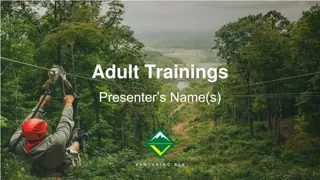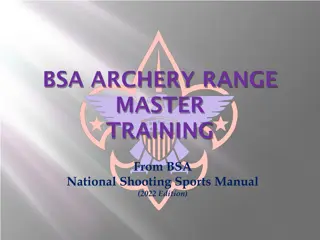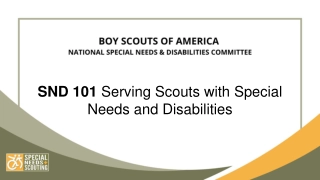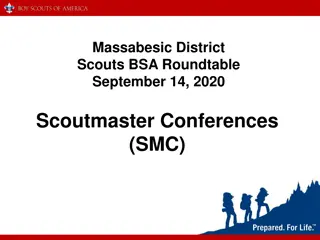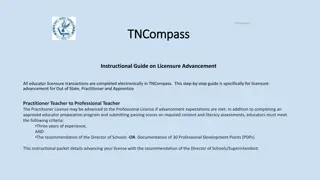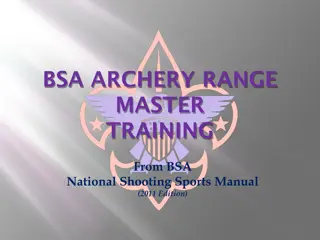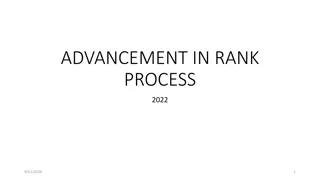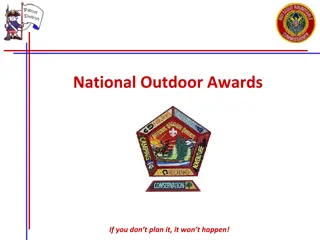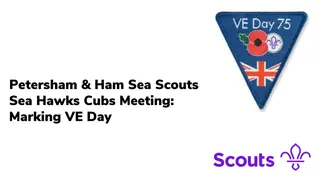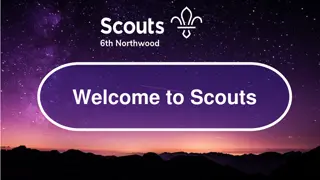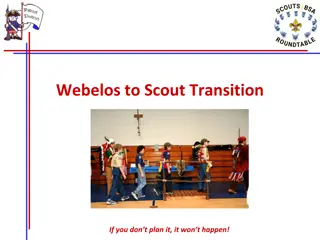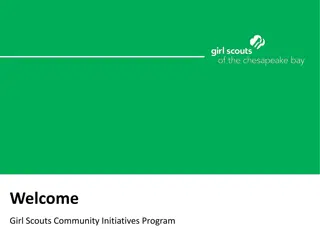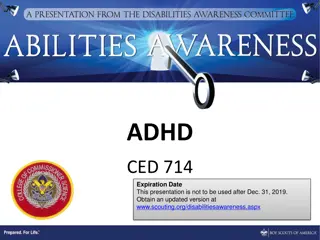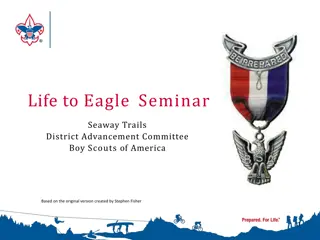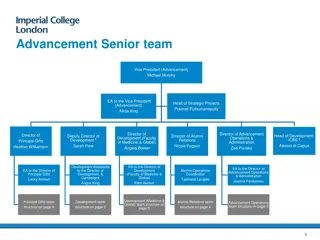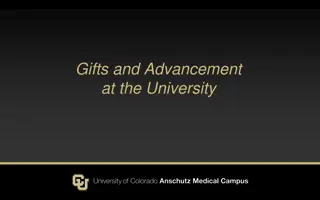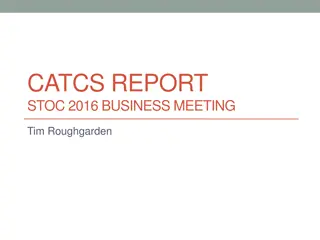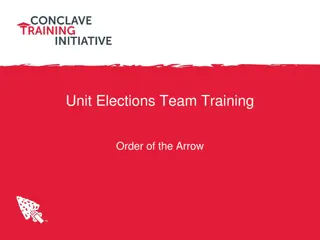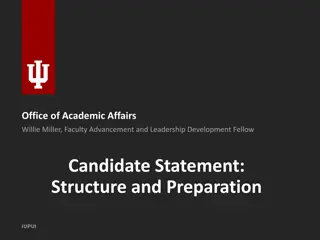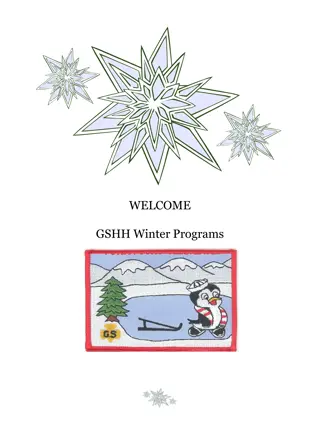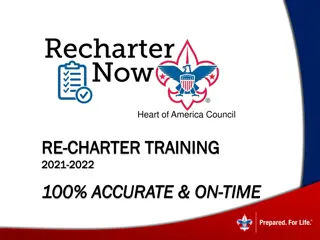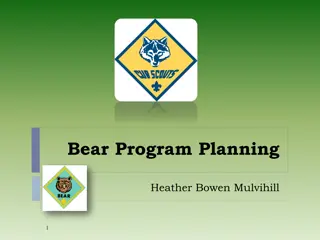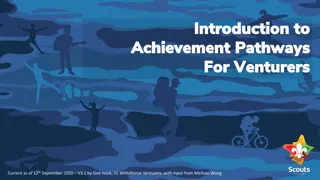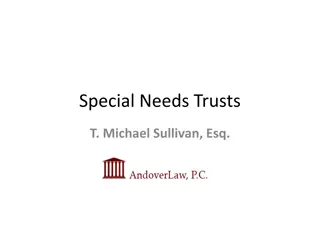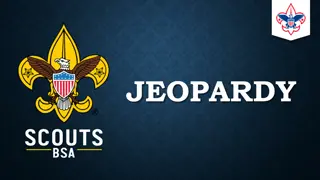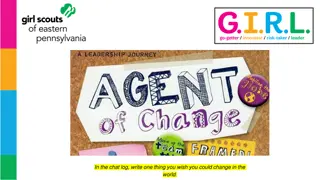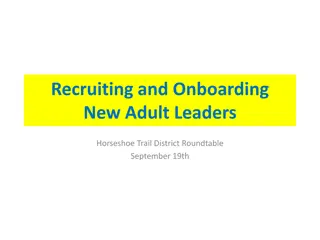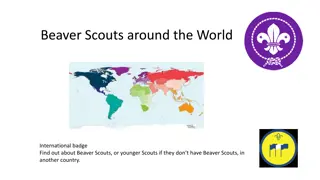Guide to Scouts BSA Advancement for Special Needs Scouts
The Scouts BSA advancement program aims at character development, leadership, citizenship training, and personal fitness for all scouts. Personal growth is the primary goal, and advancement is based on experiential learning. Challenges lead to personal growth, and there are four steps in Scouts BSA advancement: learning, testing, reviewing, and recognition. Scouts must meet current requirements without exceptions.
Download Presentation

Please find below an Image/Link to download the presentation.
The content on the website is provided AS IS for your information and personal use only. It may not be sold, licensed, or shared on other websites without obtaining consent from the author. Download presentation by click this link. If you encounter any issues during the download, it is possible that the publisher has removed the file from their server.
E N D
Presentation Transcript
Guide to Scouts BSA Advancement in the Troop for special needs Scouts 10/12/23 v1 1
Aims of the Scouting Program Character development Leadership development Citizenship training Personal fitness (mental and physical) Every activity in Scouting should support one or more of these aims. 2 10/12/2 3 v1
The Goal An observation: Practically everything a boy or girl does in Scouting provides an opportunity for learning and growth. Personal growth is the primary goal. GtA 2.0.0.3 3 10/12/2 3 v1
Methods of Scouting Scouting ideals Patrol method Outdoor programs Advancement Association with adults Leadership development Uniform Personal growth 4 10/12/2 3 v1
Challenge leads to personal growth The advancement program is meant to challenge our members; however, not all of them can achieve everything they might want to with or without a disability. It is for this reason all Scouts are required to meet the requirements as they are written, with no exceptions. 10/12/23 v1 5
Main principle: Advancement is based on experiential learning Everything done to advance is designed to educate or to otherwise expand horizons. Scouts learn and develop according to a standard. Experiential learning is the key: Exciting and meaningful activities are offered, and education happens. Learning comes from doing. For example, youth may read about first aid, hear it discussed, and watch others administer it, but they will not learn it until they practice it. Rushing a Scout through requirements to obtain a badge is not the goal. GtA 2.0.0.2 6 10/12/2 3 v1
Four Steps in Scouts BSA Advancement 1. The Scout learns. 2. The Scout is tested. 3. The Scout is reviewed. 4. The Scout is recognized. (1+ and/or 2+) The Scout uses the skills (opportunities to practice; reinforces the learning; retention through repetition). GtA 4.2.1.0 7 10/12/2 3 v1
Advancement Principles The Scout must meet the most current requirements for advancement and MBs. The requirements in effect at the time the Scout begins to complete his/her first requirement for a rank or MB. The Scout must show his/her stuff The Scout is expected to meet the advancement and MB requirements as they are stated - no more and no less. He/she must do exactly what is stated in the requirements. No council, committee, district, unit, or individual has the authority to add to, or subtract from, advancement requirements. Once tested and signed off, the requirement is earned. 8 10/12/2 3 v1
Keeping things in perspective for special needs Scouts Advancement is a method of scouting, not the mission What is expected of scouts with and without disabilities Achievable challenge All in good time Comparable challenge Having fun The outcomes of the Scouting experience should be fun and educational, and not just relate to completing rank requirements that might place unrealistic expectations on a member who has special needs. GtA 10.2.2.0 10/12/23 v1 9
Options available for Scouts with special needs and disabilities Simple accommodations (modifications) to meeting requirements that provide a very similar challenge and learning experience. Substituting alternative requirements for regular requirements for the ranks of Scout through First Class Substituting merit badges for badges that are Eagle-required Getting to remain in Scouts BSA indefinitely (and continue to work on advancement) 10/12/23 v1 10
What does the unit need to do? Unit leaders - Think about and plan for how to work with the Scout, given his/her special needs [Be knowledgeable and Be prepared] Read the Introduction to working with Scouts with special needs and disabilities, No 510-071 Read the applicable sections in the Guide to Advancement, Section 10 Regular involvement with the Scout (consider a mentor or coach) Have a pre-joining conference Talk with the Scouts in the unit Encourage the Scout Involve the parents or guardians, at least regularly consult 10/12/23 v1 11
The challenge of timing for special needs Scouts A Scout is expected to complete every requirement or merit badge possible for a given rank before an alternative rank requirement or merit badge can be formally approved. In general, a Scout is not allowed to attempt to complete an alternative requirement or merit badge until after the alternative has been formally approved. 10/12/23 v1 12
What are the steps for ranks of Scout, Tenderfoot, Second Class, and First Class? [ 1 of 2] Complete as many of the requirements as possible May involve simple accommodations (modifications) to meeting requirements that provide a very similar challenge and learning experience. Unit leaders should agree in advance on these accommodations. Once the Scout s best has been done to the limit of the Scout s abilities and resources, submit to the council advancement committee a written request for alternative requirements. 10/12/23 v1 13
What are the steps for ranks of Scout, Tenderfoot, Second Class, and First Class? [ 2 of 2] Request should include: A specific request from scoutmaster or committee chair. A letter from a parent, guardian, or Scout petitioning the Scout council for the exception. A supporting letter from the unit leader that endorses the request for an exception. A letter of explanation from the Scout directly (when possible). A completed medical form. A written statement from a qualified health professional. Copies of existing plans for treatment or accommodations are not mandatory, but can help. 10/12/23 v1 14
What are the steps for alternate merit badges for MBs that are Eagle required? [ 1 of 2] Note: Individual requirements for a MB may not be changed or substituted. May only request an alternative MB. Earn as many Eagle-required MBs as possible. Like rank requirements, may involve simple accommodations (modifications) to meeting requirements. Exception: situations where the need for an alternative is obvious. Then, must earn First Class rank first. Once the Scout s best has been done to the limit of the Scout s abilities and resources, submit to the council advancement committee a written request for alternate MBs. Note: MBs already earned may not substitute. 10/12/23 v1 15
What are the steps for alternate merit badges for MBs that are Eagle required? [ 2 of 2] Request should include: Application for alternative Eagle Scout rank merit badges. A letter from a parent, guardian, or Scout petitioning the Scout council for the exception. A supporting letter from the unit leader that endorses the request for an exception. A letter of explanation from the Scout directly (when possible). A completed medical form. A written statement from a qualified health professional. Copies of existing plans for treatment or accommodations are not mandatory, but can help. 10/12/23 v1 16
Resources available Use the council s advancement section on the council s website as a go-to source for information and required documents susquehannabsa.org/advancement Guide to Advancement, Section 10.0.0.0 Introduction to working with Scouts with special needs and disabilities, No 510-071 The inclusion toolbox Individual Scout Advancement Plan, No 512-96 Alternative requirements summary of procedures to apply Application for alternative Eagle Scout rank merit badges 10/12/23 v1 17
A word about time It Takes Time Once a Scout reaches the rank of First Class, each Scout needs to be coached repeatedly on the time it will take to complete the requirements for Star, Life, and Eagle. It is an opportunity to reinforce the life lesson of planning ahead. Major points to reiterate with the Scout: Each of these ranks has a non-negotiable minimum period to be active in the troop and serve in one or more specified position of responsibility. Meeting some requirements for rank advancement and MBs will take longer than expected. The Scout will have to balance time available to work on advancement and MB requirements with commitments to other aspects of his life (family, school, sports, other activities, other interests, work). At times, the Scout will have to adapt to the schedules of others. For the best experience, a Scout should earn the Life rank before turning 17. 18 10/12/2 3 v1
Questions?? 19 10/12/2 3 v1
Advancement Functions Planning Preparation Teaching or training (Learning) EDGE Testing Recording Reviewing Recognizing 20 10/12/2 3 v1
Advancement Roles Scoutmaster Assistant Scoutmasters Committee chair Advancement coordinator Committee members Youth leaders (SPL, ASPL, PLs, Troop Guide, Junior Asst SM) Chartered Organization Rep Each troop needs to decide the role each position will be play in performing the advancement functions, as well as the expectations and procedures. 21 10/12/2 3 v1
Digging into a few advancement requirements Demonstrate Scout Spirit GtA 4.2.3.2 Service Projects GtA 4.2.3.3 Unit leader (Scoutmaster) conference GtA 4.2.3.5 Active participation (Star, Life, Eagle) GtA 4.2.3.1 Positions of responsibility (Star, Life, Eagle) GtA 4.2.3.4 22 10/12/2 3 v1
Merit Badges GtA 7.0.0.0 Should always start with meeting with the unit leader for every MB the leader s opportunity to give guidance on the wisdom of pursuing a selected badge, to advise the Scout on how work might be approached, and what may be encountered along the way. also the time to provide the names and contact information for one or more approved counselors. The best outcome is that a growth-oriented, positive dialog occurs that provides inspiration and direction in a Scout s life and even leads to conversations about talents and interests, goal setting, and the concept of challenge by choice. Encourage interaction and association with adults outside the troop Workbooks can not require and have limited use in meeting requirements 23 10/12/2 3 v1
Boards of Review (1 of 2) GtA 8.0.0.0 Composition The board is made up of three to six unit committee members no more and no less. In units with fewer than three registered committee members available to serve, it is permissible to use knowledgeable parents (not those of the candidate) or other adults (registered or not) who are at least 21 years of age and who understand Scouting s aims. Using unregistered adults for boards of review must be the exception, not the rule. GtA 8.0.2.0 Unit leaders and assistants shall not serve on a board of review for a Scout in their own unit. Parents, guardians, or relatives shall not serve on a board for their child. The candidate or the candidate s parent(s) or guardian(s), or relative(s) shall have no part in selecting any board of review members. GtA 8.0.0.3 The Unit leader may be present to observe. GtA 8.0.1.0 24 10/12/2 3 v1
Boards of Review (2 of 2) GtA 8.0.0.0 Conducting the board it should, , be a celebration of accomplishment. Remember, it is more about the journey. Not a retest or examination GtA 8.0.1.1 What should be discussed. GtA 8.0.1.2 25 10/12/2 3 v1
Some best practices Use the council s advancement section on the council s website as a go-to source for information and required documents susquehannabsa.org/advancement Establish some advancement policies and procedures for the troop Assign unit leaders as a mentors for each rank to monitor and encourage progress, including information and guidance to move forward Reinforce learning from completion of advancement requirements through troop activities Units should plan for timely opportunities to review (BoRs) and recognize (CoHs) the advancement achievements of the Scouts 26 10/12/2 3 v1
Worksheets and Learning Aids Merit badge worksheets from the Web or other sources are unofficial, but may aid in learning. These tools must relate to current BSA requirements, which still must be fulfilled as written. Worksheets may be used to meet in writing requirements. Worksheets are not a substitute for telling, showing, or demonstrating, etc. Scouts must not be required to use them. Guide to Advancement topic7.0.4.8 27 10/12/23 v1


